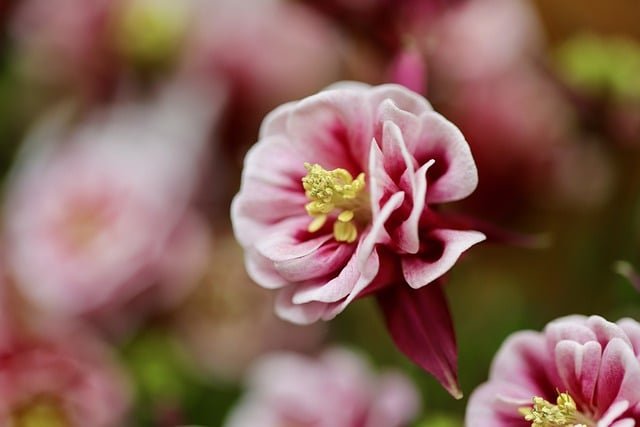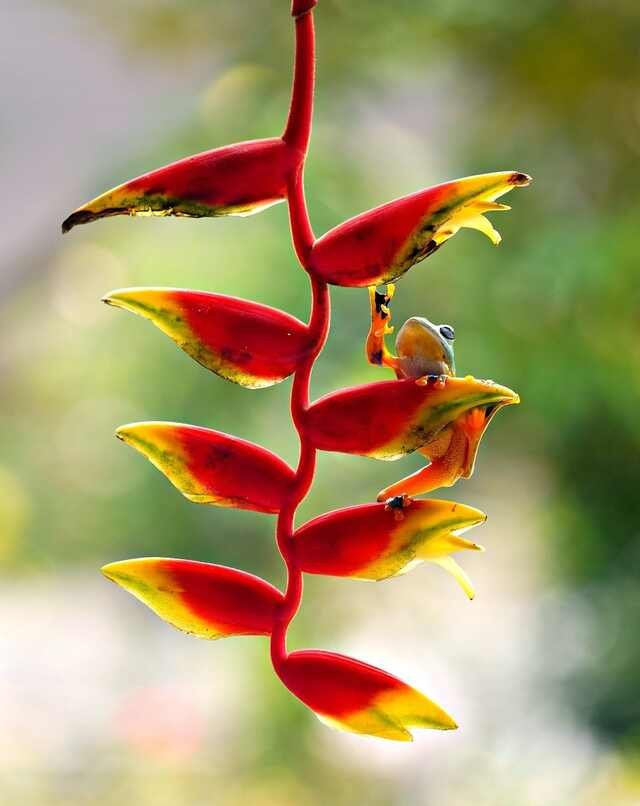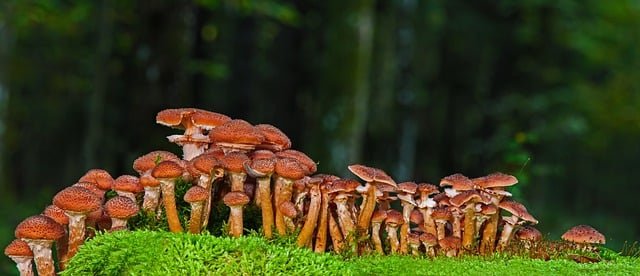These flowers are almost all self-seeded. Almost all the plants you see here are self-seeded. Some arrived on the wind, and some are the great-great-grandchildren of plants that I planted long ago. These self-seeders mean that I haven’t actually had to buy any extra plants to fill gaps in my border this year. So it’s plants for free, and because they’ve chosen where they want to grow, they’re very easy care. They don’t need fertilizing, they don’t need staking, they just pop up and they grow.
Alliums
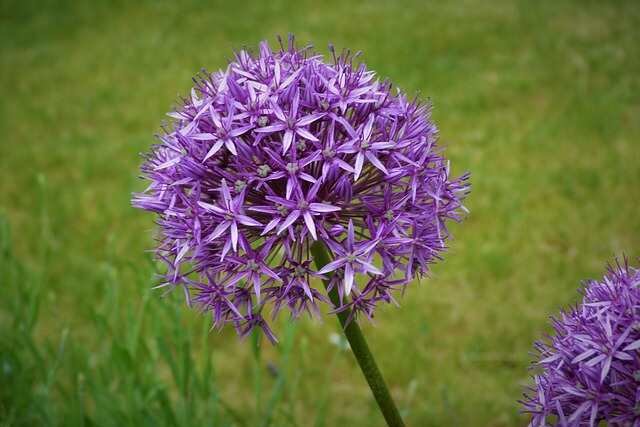
Today I’m going to pick out around 18-plus of my favorite self-seeders. They’re all plants that grow in a wide range of climates and zones. I’ll start with alliums, which make such a pop of color in midsummer.They are quite well-behaved. They tend to stay in the same border that I planted them in.
Alchemilla mollis

Alchemilla mollis runs between the cracks of our pavers. Weeding between pavers is really quite a tedious job, so a couple of years ago I decided that we would only weed out the plants we don’t want between the pavers, and we would allow the plants we do want—Alchemilla mollis and daisies—to grow between the pavers. This stops the weeds from landing in those cracks, and it makes it much easier—we do far less weeding now.
Daisies
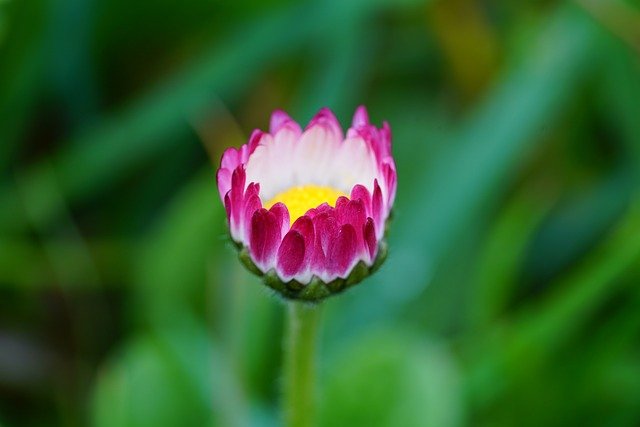
There are two kinds of daisies that will grow between pavers. One is the lawn daisy, Bellis perennis, and the other is the Mexican daisy, Erigeron karvinskianus. They’re not actually related by DNA, but they are both very resilient little plants. It really isn’t going to matter if you tread on them—particularly not the lawn daisy, which has always been trodden on. I personally would love to have more Erigeron in this garden because my neighbors have absolutely beautiful Erigeron in their front garden, and it looks gorgeous coming out of the cracks in their stonework.
One thing about self-seeders is that they very much choose where to be. If they’ve chosen not to be in a particular part of your garden, there’s not much you can do about it. If you’re an avid weeder, you won’t get as many self-seeders because anything you do to get rid of weeds will also get rid of the self-seeders, such as putting on a heavy bark mulch. But if you are an avid weeder and you want self-seeders, then just get to know what the smaller plants look like, and you’ll be able to leave some of those in.
Aquilegia
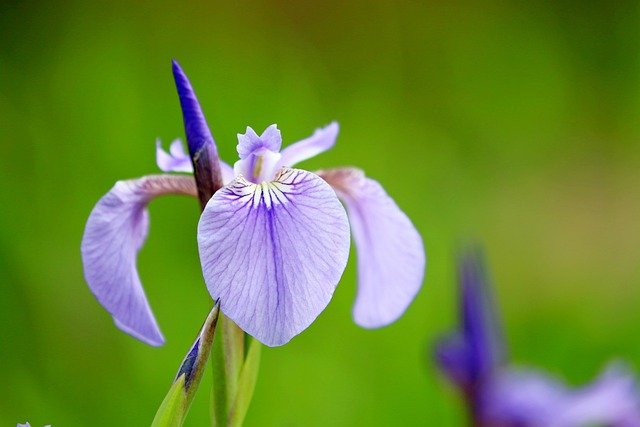
Aquilegia often goes into the list of best self-seeding plants. It hasn’t been one of my best self-seeding plants. And that’s another thing about self-seeders—it’s very dependent on not just your climate and your soil but also your microclimate and whether your garden is sheltered or perhaps a bit exposed to the wind. All sorts of things mean a plant self-seeds well in your garden but may not self-seed well in my garden. But Aquilegia still self-seeds well enough to belong in this list because its beautiful delicate flowers pop up just like a little surprise around the borders.
Borage
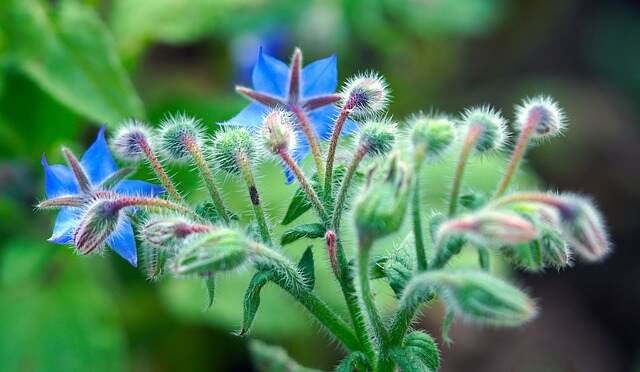
One plant I’ve always wanted is borage, and one day it appeared. It blew in on the wind, landed in one of my borders, and is now scattered all around the garden. I am going to have to take quite a strong line with pulling it out, but I do love its fluffs of gray foliage, and the tiny pretty little flowers are adored by pollinators. It also chose to land amongst the stems of this rose, and as the stems of a rose are never the most beautiful part of the plant, I’m actually rather delighted with that.
Cerinthe
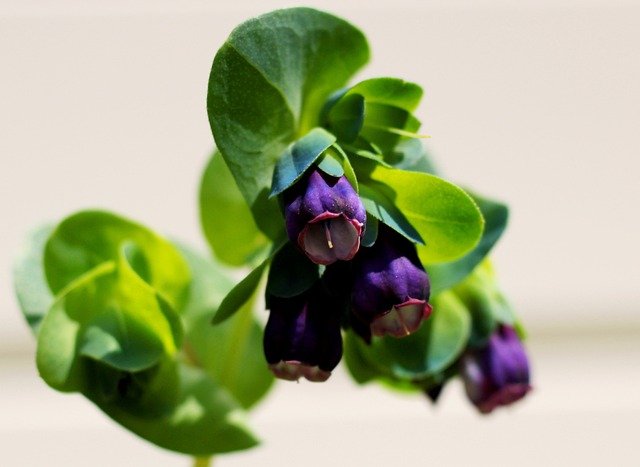
Some self-seeders are plants that you grow yourself from seed, and then you just let them self-seed around the garden. Cerinthe, or honeywort, is one of these. When I first grew cerinthe, I planted it into seed trays. I had a whole packet of seeds, and I really only got one or two plants. I planted them out, and they didn’t look all that happy. But ever since then, I’ve had lovely clumps of cerinthe. They’ve got beautiful blue flowers that go from about mid-spring to midsummer, and they are once again loved by pollinators. That is the thing about self-seeders—they need to have good flowers in order to be pollinated by nature. So you may find that some plants grow better as self-seeders than they do as plants that you’ve deliberately planted. Cerinthe is certainly one of those for me.
Crocosmia
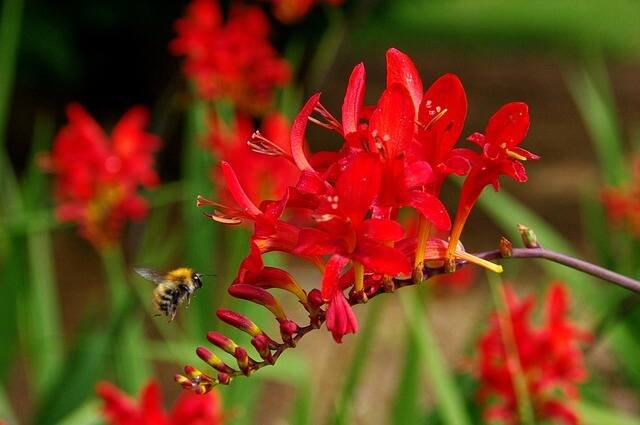
Crocosmia brings up another issue for self-seeders. The crocosmia was in our garden when we arrived, and it has wonderful scarlet flowers and lovely architectural seed heads. However, since it was planted in this garden, it has gone onto a government list of plants that should not be grown in the wild, or allowed to grow in the wild. Now the word “invasive” is used by gardeners in different ways, but definitely, self-seeded plants are more likely to be invasive. The most common use is people say “oh, that’s invasive,” and it means it goes much further or faster than you really would like. And that’s very much up to you as to what you’re prepared to put up with. But the more important definition of invasive is when it’s on a list of invasive plants which are forbidden to be sold, bought, planted, or allowed to grow in the wild, etc. Those lists are on government websites. The problem with those plants is that they’ll self-seed into the countryside, out-compete local plants, and that means that local wildlife may be deprived of habitat or food sources. So when you’re planning self-seeders, check whether they’re invasive near you by going online and searching “is [name of plant] invasive in [name of your area]” and see if it’s on any government lists. Here, crocosmia has been put on a government list.
Euphorbia oblongata
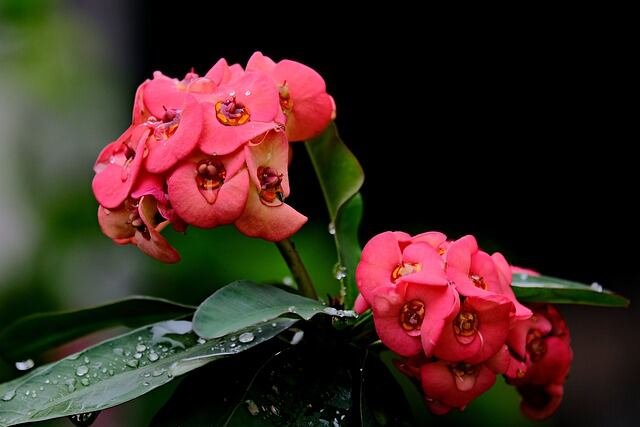
Another self-seeder I’ve got, Euphorbia oblongata, is very invasive in some states in the United States, but it’s fine here. That’s why I say it’s really important to find out what is technically invasive near you, rather than simply accepting someone saying “oh, that’s an invasive plant.”
Cyclamen
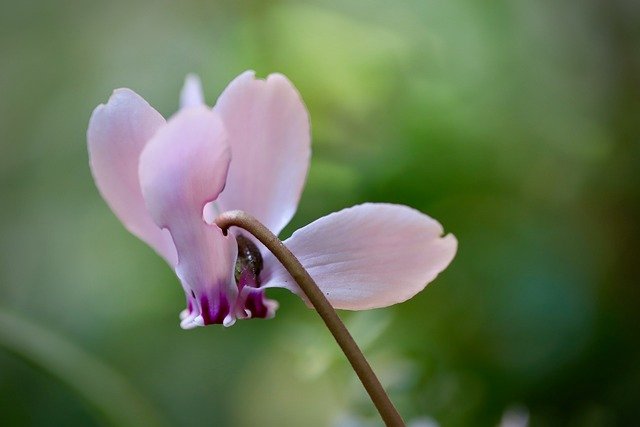
One of the most charming and delightful self-seeders, particularly for autumn, winter, and early spring, is cyclamen. Their flowers—white or pink—appear in autumn and winter, and then the leaves, which are pretty little heart-shaped things, are just such a joy covering the ground in spring and early summer. Then they disappear under the soil. There’s a group of cyclamen in my garden that have popped up with a whole load of sweet woodruff, which is another delightful early spring self-seeder with little white flowers. One thing about cyclamen is that you can buy pots of what’s called florist cyclamen; that isn’t so hardy. If you plant those in the garden, they may not survive your winters. They certainly won’t if they’re very cold.
Gladiolus
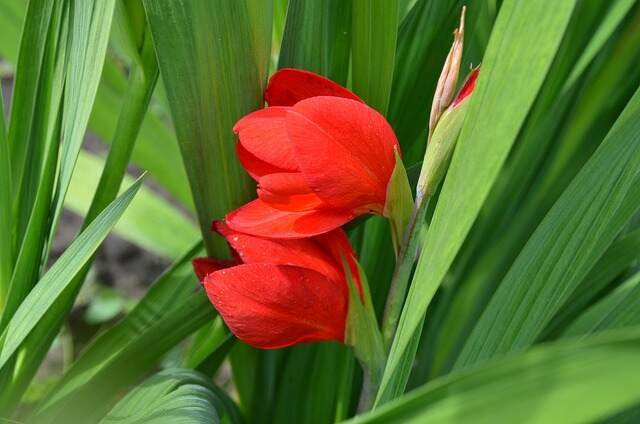
There’s one self-seeder that’s very special in this garden, and that’s Gladiolus communis or wild gladioli. When we moved in, we met somebody who had been born in this house in 1937, and he remembers wild gladioli in the garden in his childhood. There was also a botanic artist who grew up here in this house in Victorian times, and she used to paint wild gladioli. So I think we can safely say that this plant has been self-seeding in this garden for well over 100 years. It dances around in different borders and spreads around the garden, but it tends to pop up only in the sunniest spaces.
Lychnis coronaria

Lychnis coronaria, or rose campion, is one of my favorite self-seeders. This one comes from a couple of plants which I bought probably eight or nine years ago, and it’s self-seeded since then. It self-seeds all around the garden, going into paths and pavers and things like that. Last year, I gathered up a lot of the tiny little plants and grouped them together so that they would all come out in a clump. But it also self-seeds in a clump.
Foxgloves
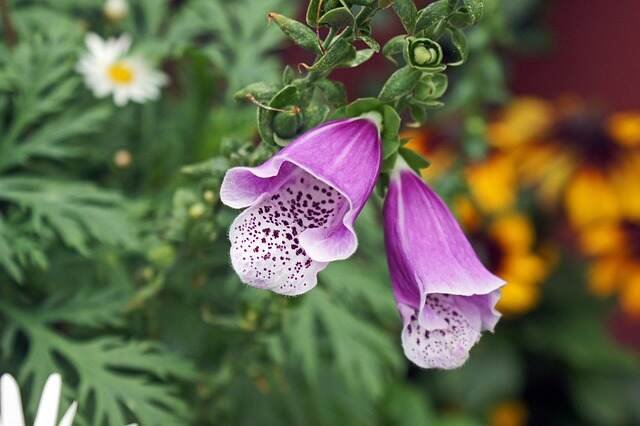
Foxgloves are absolutely at the heart of my late spring and summer garden. That’s another plant that I found grows better as a self-seeder than when you plant them. I don’t think I’ve really succeeded in planting any foxgloves. They just always seem to have been here. One thing I always find quite amusing about foxgloves is that they seem to have this color sense; the pink foxgloves go with the other pink flowers, the purple foxgloves with the purple alliums, and white foxgloves next to silver birch. They’re really considerate about how they place themselves.
Marigolds
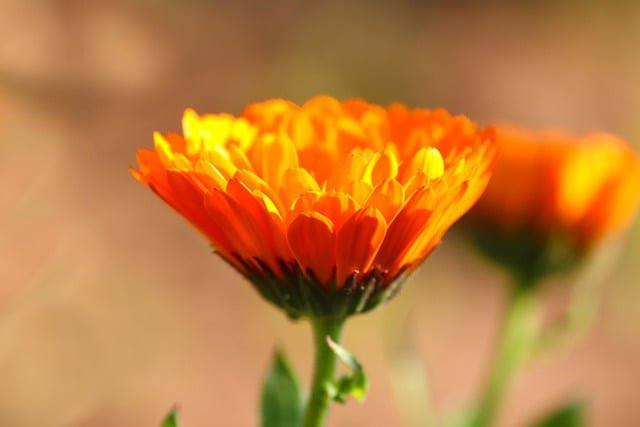
Marigolds and primroses are two of the most common self-seeders, and they are both charming. One thing about marigolds is that it’s a good companion plant. I used to let it self-seed in my veg patch. The courgettes that grew near the marigolds didn’t have as many aphids as the ones that were further away. I don’t think there’s any scientific research on that, but that’s just my experience. As for primroses, they are such a charming sight in late winter and early spring. They are the easiest plants you can imagine. Other plants crowd them out, and then when the other plants have gone away, the primroses are back. They don’t seem to worry about anything, and they really are completely charming. They’re another plant that provides a really good early source of pollen. If you have a sunny day in winter, bees can wake up, and if there aren’t any flowers, there’s nothing for them to eat.
Smyrnium perfoliatum
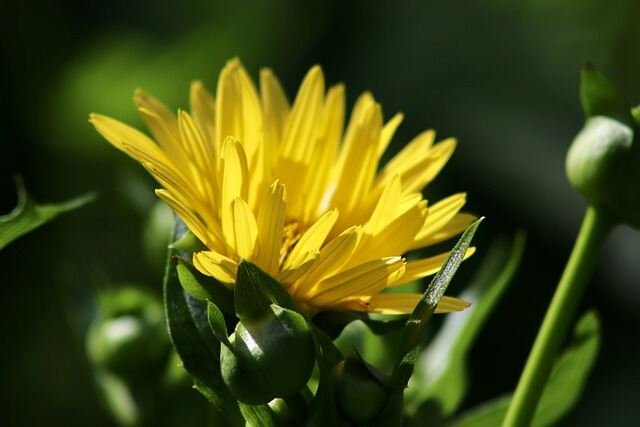
One of the most striking plants in my garden in spring is Smyrnium perfoliatum, and that really does spread around the garden very vigorously. I planted just three plants which I bought as seedlings literally around 20 years ago, and now we’ve got it in several borders in the garden. Smyrnium perfoliatum is well-admired; everybody loves it. However, it is beginning to spread into the countryside, and I think there is a possibility that it will be named as an invasive plant at some point in the future. So it is worth considering if you live very close to open countryside or coastland which it could invade.
Nigella

Nigella is another one that I don’t find to be a very good self-seeder. It pops up here and there, it’s a beautiful delicate flower, and it’s also a very good cut flower. So it’s worth having, but it’s probably never going to be a nuisance, although that does vary from garden to garden.
Poppies
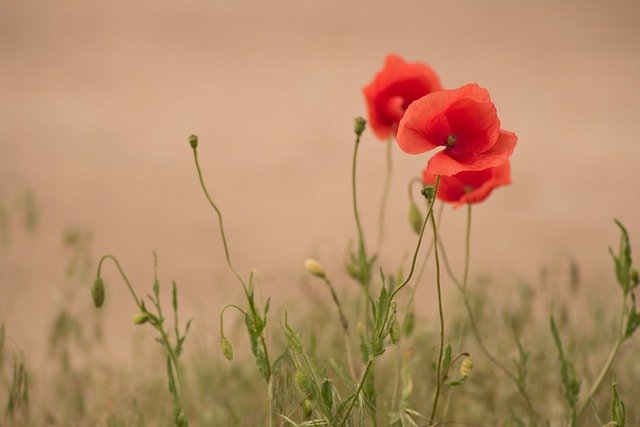
Where would any discussion of self-seeders be without poppies? Poppies emerge when the ground is turned over. Famously in the First World War, the trenches and the tanks and everything really stirred up the soil, so when the war was over, all the poppy seeds had been stirred up, and there were miles and miles of red poppies—which have now come to stand for remembrance of the dead and also hope. So wherever you’ve turned over your soil, you’ll bring poppy seeds to the surface. I’ve wanted lilac poppies because my neighbor has some lovely lilac poppies, so I’ve thrown lilac poppy seed into the borders. Absolutely nothing’s happened. Red poppies have popped up. Occasionally, a lilac poppy pops up, and then it sort of merges with the red poppy. Once again, this is another plant that really does what it wants to do. It doesn’t necessarily do anything you’ve designed it to do.
Sisyrinchium
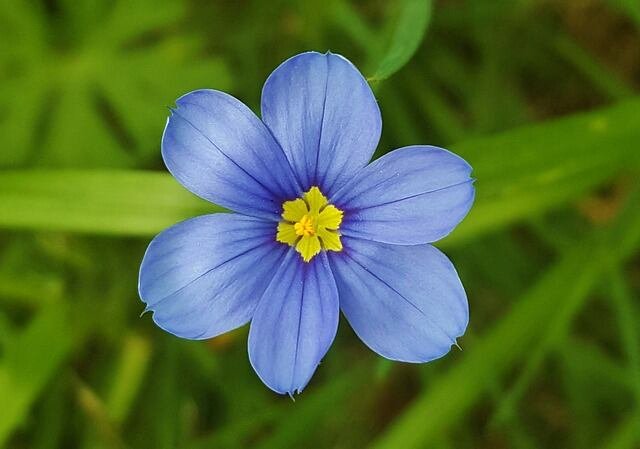
Sisyrinchium is another plant that I’ve never planted. I don’t think it was in the garden when we came. It has scattered around the garden quite a lot. It’s probably the one I pull up more than anything. It really is quite persistent, but I do like its creamy spikes in the border. It’s also called yellow-eyed grass.
Linaria purpurea
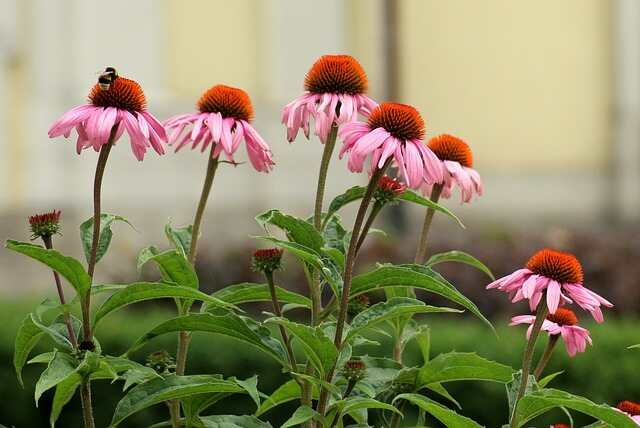
Another spiky plant, which many people consider to be a weed, is purple toadflax or Linaria purpurea. I used to weed this out. It’s a very good food source for caterpillars, and its flowers are beautiful. This year, I’ve let it spread much more, and I think it really contributes to the garden. This is a shot I took really late, just after the sun had gone down, and I think you can see how the blues and purples work really well together.
Verbena bonariensis
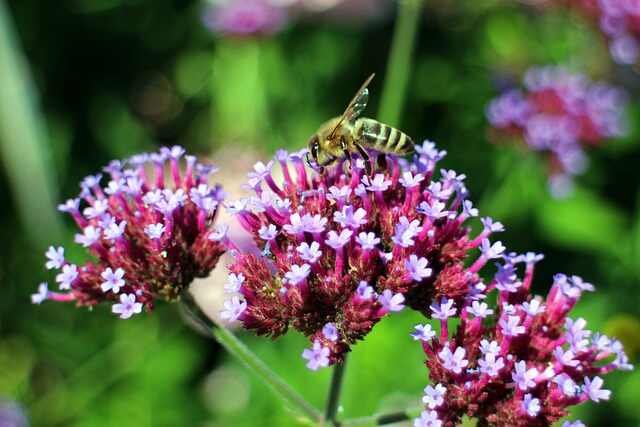
One of the most popular plants of today is Verbena bonariensis because it has really long stalks, so you can plant it at the front, the middle, or the back of a border. Its flowers are beloved by pollinators, and it makes a great cloud of purple that you can see through, and it does self-seed very well. However, I’ve found that if you just plant one or two Verbena bonariensis under the impression that you will soon get a clump, you don’t really get a clump. If you plant a clump to start with—and a friend gave me a whole load of plants one year—then you will get some regular self-seeding. So you need to put quite a lot of Verbena bonariensis in to start with, to get a good self-seeding going.

